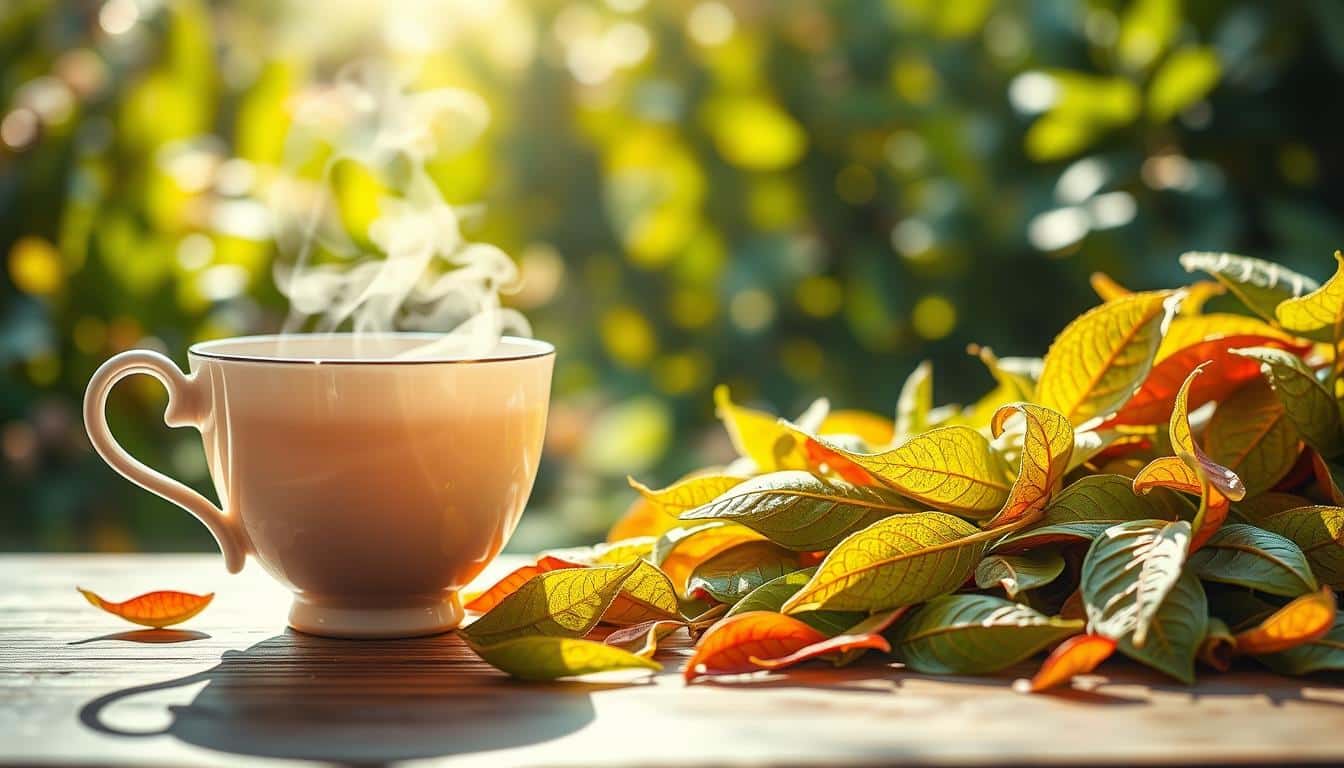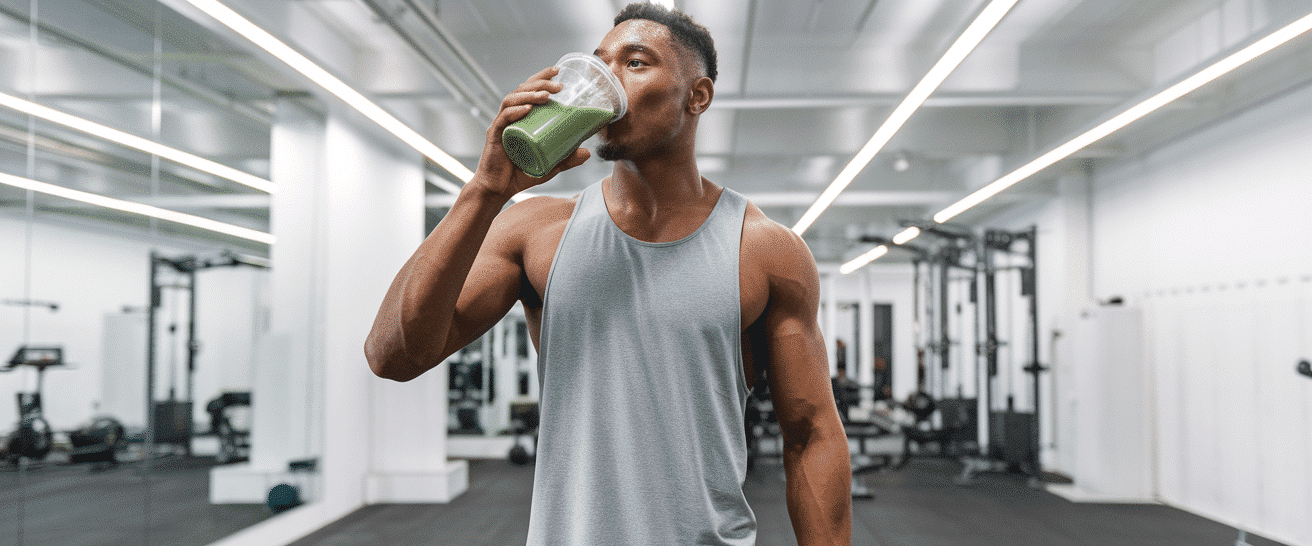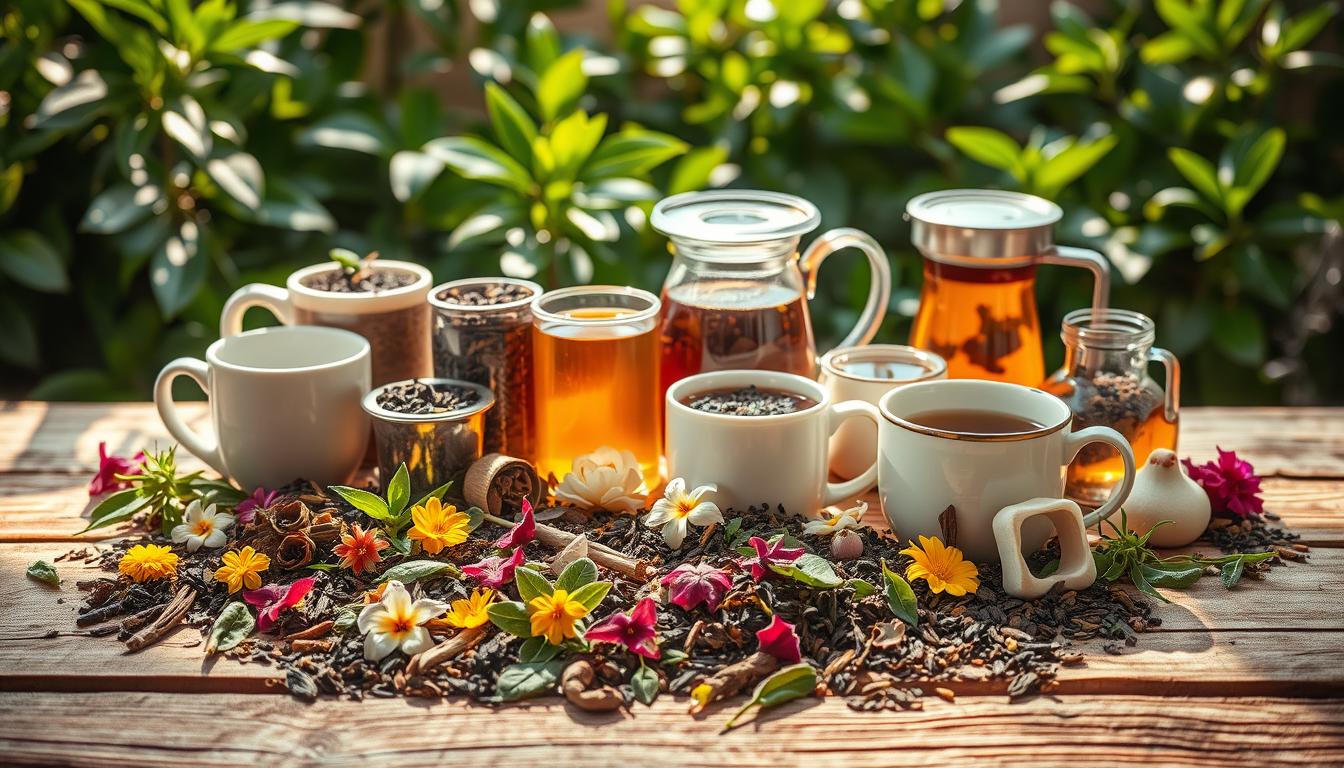Three out of four Americans operate in a constant state of dehydration. That’s enough people to fill New York City eight times over – and it directly impacts how you perform during workouts or bounce back afterward.
Since our bodies are two-thirds water, every system depends on proper fluid balance. But chugging endless glasses gets tedious. Here’s where nature’s original sports drink shines: brewed leaves offer nutrients plain H₂O can’t match.
Certain varieties act like multitasking hydration heroes. They deliver antioxidants that fight exercise-induced stress while keeping your cells plump with moisture. Unlike sugary alternatives, these infusions work with your body instead of against it.
We’ll explore how specific blends help you recover faster and stay energized between sessions. You’ll learn which options taste great cold-brewed in your gym bottle and why some herbs beat commercial supplements at their own game.
Understanding Hydration and Muscle Recovery with Tea
Imagine your body as a high-performance engine—without proper fluids, it sputters and stalls. Water maintains everything from joint lubrication to brain function. But what you drink matters just as much as how much you drink.

Role of Water and Tea in Health
Your cells need water like tires need air. Without it, energy plummets and focus fades. While plain water works, infused options like brewed leaves add nutrients your system craves during physical stress. A 30-minute workout can drain 16-24 ounces of fluids—many folks don’t replenish enough.
Simple Benefits for the Body
Herbal blends do double duty. They replace lost moisture while delivering plant compounds that ease post-exercise stiffness. For example, peppermint soothes digestion, and hibiscus packs vitamin C. It’s like upgrading from regular fuel to premium.
| Water | Tea | |
|---|---|---|
| Primary Function | Basic hydration | Hydration + nutrients |
| Added Nutrients | None | Antioxidants, vitamins |
| Hydration Efficiency | High | Equal to water* |
| Recovery Support | Limited | Muscle relaxation |
*Studies show moderate caffeine intake doesn’t dehydrate
Your needs shift daily. Hot weather or intense sessions? Reach for drinks that multitask. Next time you refill your bottle, ask: “Is this helping or just wetting my throat?”
How Tea Hydrates Without Dehydrating Effects
Ever been told your morning brew might dry you out? Let’s clear the fog around caffeine and hydration. Science now shows these beverages work with your body more than we once thought.
Caffeine Concerns Clarified
You’ve likely heard caffeine dehydrates you. Recent studies flip this script. While it’s true that compounds in brewed leaves act as mild diuretics, they don’t drain your fluid reserves. Your body simply processes liquids faster – like a well-oiled conveyor belt moving packages without losing cargo.

Scientific Findings on Tea Hydration
Research confirms moderate consumption keeps you balanced. One trial tracked athletes drinking four cups daily – their hydration markers matched water drinkers. Another found urine output differences were negligible below 500mg caffeine (about 10 cups).
Key takeaways:
- Diuretic effects get overstated – you retain most fluid from each cup
- Electrolytes in certain blends enhance cellular water absorption
- Regular drinkers develop tolerance to caffeine’s bathroom urges
Your post-workout mug does double duty. It replaces sweat loss while delivering recovery-boosting compounds. Next time someone warns about dehydration, share the evidence – then sip confidently.
Nutritional Benefits of Herbal and Regular Teas
The secret to faster recovery might be in your teacup. While water keeps you hydrated, brewed leaves and herbs deliver extra nutrients your body needs after physical activity. Let’s break down why these infusions work harder than ordinary drinks.
Antioxidants and Natural Properties
Think of antioxidants as microscopic shields for your cells. They combat damage from exercise, pollution, and daily stress. Herbal teas like chamomile and hibiscus contain polyphenols – plant compounds with proven anti-inflammatory properties that soothe sore muscles.
Here’s how different options stack up:
| Type | Key Antioxidants | Unique Properties | Common Sources |
|---|---|---|---|
| Herbal Teas | Flavonoids, anthocyanins | Muscle relaxation, better sleep | Chamomile, peppermint, rosehip |
| Regular Teas | Catechins, EGCG | Energy support, mental focus | Green, black, oolong |
These natural compounds do more than fight inflammation. Some help lower blood pressure naturally, while others boost immunity. The best part? You absorb them easily through simple daily consumption.
Swapping one sugary drink for herbal tea gives you benefits plain water can’t match. Try cold-brewing hibiscus for post-workout recovery or ginger before bed. Your body will thank you by bouncing back faster tomorrow.
Real Teas vs Herbal Teas for Optimal Hydration
Your hydration strategy might need a botanical reboot. Not all brewed drinks come from the same source, and understanding their origins helps you maximize benefits. Let’s explore two categories: true teas from a single plant and herbal blends that borrow nature’s pharmacy.
Camellia Sinensis Explained
Every black, green, or oolong variety starts here. The Camellia sinensis bush’s leaves transform through oxidation levels. Black teas undergo full oxidation, creating bold flavors. Green types skip this step, preserving grassy notes and antioxidants. White versions use young leaves for delicate tastes.
Understanding Tisanes
Herbal options – technically called tisanes – skip the tea plant entirely. These infusions combine flowers, roots, and spices. Think chamomile blossoms or ginger root steeped in hot water. They’re naturally caffeine-free, ideal for evening relaxation or sensitive systems.
Here’s how to choose:
- Reach for real teas when you want gentle caffeine boosts with hydration
- Opt for herbal blends post-workout or before bed for muscle recovery
- Mix both types throughout the day for varied nutrient intake
Both categories keep you hydrated while delivering unique compounds. The key lies in timing – match the brew to your body’s current needs. Morning workout? Try green. Evening wind-down? Hibiscus shines.
Choosing the best tea for hydration and recovery
What separates a good post-workout drink from a great one? The answer often lies in your selection process. Simpler options without added sugars or creamers let natural compounds shine, making every sip count toward your wellness goals.
Hydration Advantages
Lighter varieties like green and white types absorb smoothly into your system. Unlike their bolder black and oolong cousins, they cause less frequent bathroom breaks. This makes them ideal for maintaining fluid balance during moderate activity.
Research shows 4-5 cups daily work alongside water intake. Exceeding eight cups risks counterproductive effects. Your body thrives on variety – rotate options to match workout intensity and time of day.
Support for Muscle Health
Certain infusions act like natural recovery aids. Ginger root contains gingerols that ease post-exercise inflammation, while chamomile’s apigenin promotes muscle relaxation. These plant-based helpers speed up repair processes without synthetic additives.
Three rules for success:
- Prioritize plain brews over sweetened versions
- Match caffeine content to your activity schedule
- Combine different varieties for full-spectrum benefits
Your beverage choices directly impact how quickly you rebound. A well-chosen rotation keeps things interesting while delivering what your system needs most. Remember – it’s about partnership with water, not replacement.
Top Picks: Hydrating Tea Varieties
Your post-workout routine deserves more than plain water – nature’s brews offer targeted solutions. These four options stand out for their unique ability to hydrate while addressing specific recovery needs.
Chamomile, Peppermint, and Hibiscus
Chamomile works like a lullaby in liquid form. Its calming properties ease muscle tension and prepare your body for deep sleep – crucial after intense training. Studies show it may also improve digestion by reducing gut inflammation.
Peppermint delivers a cooling sensation that refreshes both mind and body. Beyond its crisp flavor, this herb soothes stomach discomfort and supports nutrient absorption. Many athletes find it helps reset their system post-exercise.
Hibiscus brings tartness packed with heart-healthy antioxidants. Research suggests it helps maintain healthy blood pressure levels – vital during recovery when circulation matters most.
Ginger and Other Refreshing Flavors
Ginger shines when workouts leave you queasy. Its natural compounds combat nausea while reducing exercise-induced inflammation. Try steeping fresh slices for maximum potency.
For variety, consider lemon balm or lemongrass. These citrusy options provide hydration without caffeine, making them perfect for evening relaxation. Rotate flavors daily to keep your taste buds engaged while covering different nutritional needs.
Simple Brewing Techniques to Enhance Hydration
Busy schedules demand smart hydration hacks. Brewing larger batches ensures you never run dry during hectic days. Let’s break down two approaches that turn preparation into a seamless part of your routine.
Bulk Brewing Methods
Start with 8-10 tablespoons of loose-leaf herbs or 10-12 bags for 2-3 liters of water. Heat until boiling, then remove from the stove. Add your leaves and let them steep 10-20 minutes – longer infusions extract more nutrients without bitterness. Sweeten while warm if needed, chill thoroughly, and store for up to five days.
Cold Brew and Iced Tea Options
Skip the heat for smoother flavors. Combine herbs with cold water in a pitcher and refrigerate overnight. This method naturally mellows sharp notes, making it ideal for those avoiding added sugar. Pour over ice with mint or citrus slices for a refreshing twist.
Batch brewing works with any variety – rotate flavors weekly to keep things interesting. Pre-made pitchers save time while delivering consistent hydration support. Remember: proper storage preserves both taste and benefits, so use airtight containers.
Simple upgrades like fresh ginger or frozen berries turn basic infusions into crave-worthy drinks. You’ll ditch store-bought options once you taste the difference homemade batches offer.
Balancing Tea Consumption for Everyday Wellness
Your daily brew routine needs smart strategies to maximize benefits. While flavored options tempt your taste buds, certain additives can quietly undermine your progress.
Avoiding Sugary Additives
Sweetened versions act like hydration thieves. That innocent teaspoon of sugar? It makes your cells work overtime to process glucose, leaving you thirstier than before. Studies reveal added sweeteners reduce antioxidant absorption by up to 25%.
For creaminess without compromise, try oat milk or almond milk instead of dairy. A lemon wedge or mint sprig adds zing without sabotaging your efforts.
Guidelines for Regular Use
Three cups daily strike the ideal balance for most people. Rotate between caffeine-free herbal teas and green varieties to amplify positive effects. Pair them with water-rich snacks like celery or berries.
People often overlook how small choices impact weight management—unsweetened brews make calorie control effortless. Remember: consistency beats intensity when building lasting hydration habits.


